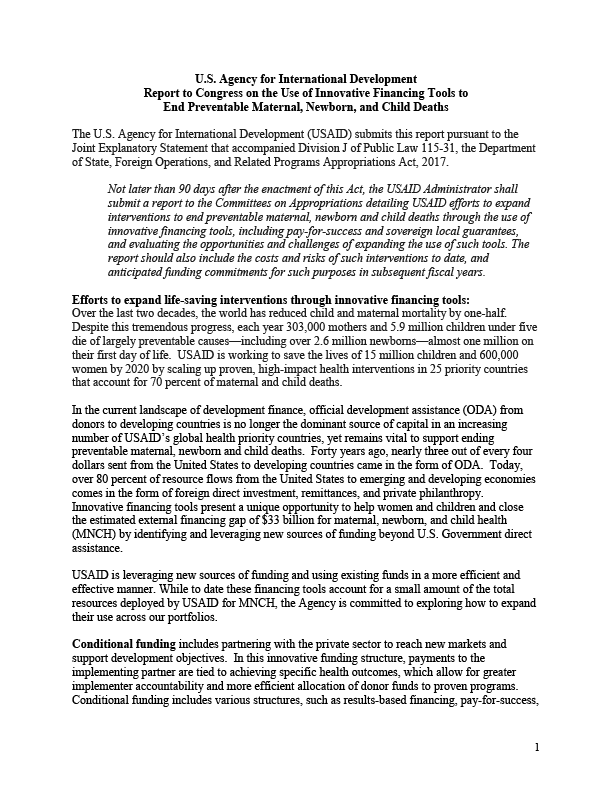Speeches Shim
The U.S. Agency for International Development (USAID) submits this report pursuant to the Joint Explanatory Statement that accompanied Division J of Public Law 115-31, the Department of State, Foreign Operations, and Related Programs Appropriations Act, 2017.
Not later than 90 days after the enactment of this Act, the USAID Administrator shall submit a report to the Committees on Appropriations detailing USAID efforts to expand interventions to end preventable maternal, newborn and child deaths through the use of innovative financing tools, including pay-for-success and sovereign local guarantees, and evaluating the opportunities and challenges of expanding the use of such tools. The report should also include the costs and risks of such interventions to date, and anticipated funding commitments for such purposes in subsequent fiscal years.
Efforts to expand life-saving interventions through innovative financing tools:
Over the last two decades, the world has reduced child and maternal mortality by one-half. Despite this tremendous progress, each year 303,000 mothers and 5.9 million children under five die of largely preventable causes—including over 2.6 million newborns—almost one million on their first day of life. USAID is working to save the lives of 15 million children and 600,000 women by 2020 by scaling up proven, high-impact health interventions in 25 priority countries that account for 70 percent of maternal and child deaths.
In the current landscape of development finance, official development assistance (ODA) from donors to developing countries is no longer the dominant source of capital in an increasing number of USAID’s global health priority countries, yet remains vital to support ending preventable maternal, newborn and child deaths. Forty years ago, nearly three out of every four dollars sent from the United States to developing countries came in the form of ODA. Today, over 80 percent of resource flows from the United States to emerging and developing economies comes in the form of foreign direct investment, remittances, and private philanthropy. Innovative financing tools present a unique opportunity to help women and children and close the estimated external financing gap of $33 billion for maternal, newborn, and child health (MNCH) by identifying and leveraging new sources of funding beyond U.S. Government direct assistance.
USAID is leveraging new sources of funding and using existing funds in a more efficient and effective manner. While to date these financing tools account for a small amount of the total resources deployed by USAID for MNCH, the Agency is committed to exploring how to expand their use across our portfolios.


Comment
Make a general inquiry or suggest an improvement.